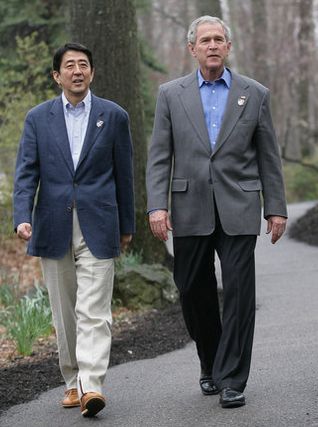Last week's two-day summit between President George Bush and Shinzo Abe, who was making his first visit to the United States as Japanese prime minister, provided an opportunity to take stock of the profound changes occurring in the bilateral security relationship. Despite Japanese-American differences over several regional security issues, the two countries have continued to strengthen their bilateral defense ties in several dimensions. The Japanese government has shown an acute interest in developing ballistic missile defenses (BMD) in cooperation with the United States. After North Korea's experimental long-range Taepo-dong 1 missile flew over Japan's mainland in August1998, the United States and Japan started a joint BMD program. Their initiative also aims to counter the hundreds of shorter-range North Korean Nodong 1 missiles capable of reaching most of Japan, including Tokyo. In 2003, the Japanese government decided to develop a multilayered defense system initially based on the Aegis BMD system and the Patriot Advanced Capability-3 (PAC-3). The United States subsequently deployed PAC-3 at key U.S. military facilities throughout Japan. The two militaries successfully tested an advanced Standard Missile-3, a missile interceptor intended for use by ships equipped with AEGIS radars, near Hawaii in March 2006. The two governments anticipate deploying an operational joint system by 2015. At home, the Abe administration has launched a major initiative to assess whether to revise the Japanese constitution. A newly appointed government panel will explicitly address the issue of whether to abandon the long-standing interpretation that the constitution excludes Japan's participation in "collective self-defense" arrangements. Past Japanese governments have cited this interpretation as a factor limiting their ability to provide direct military assistance to U.S. forces engaged in armed combat outside Japan. Many Japanese security experts would like to remove this barrier to increased Japanese-American defense cooperation. The current interpretation creates particular problems for plans to operate a joint BMD system, which for technical reasons would probably entail deep Japanese involvement if the system were used to defend American forces under missile attack in East Asia.
<<ad>>
Under the auspices of their bilateral Security Consultative Committee (SCC), the two governments have engaged in a major effort to restructure their defense alliance. For several years, the SCC has been issuing joint statements articulating the two countries' common strategic objectives, establishing new roles and missions for their defense forces, and announcing revisions in U.S. military deployments in Japan. In particular, the two governments have devoted much attention to developing and implementing plans to transfer U.S. military forces from Okinawa to Guam, integrating U.S. and Japanese military headquarters and training facilities in Japan (including at Camp Zama and Yokota Air Base), and improving bilateral cooperation in 16 specific mission areas (such as air defense, critical infrastructure protection, and human relief operations).
Japan-U.S. Summit Reaffirms Bilateral Security Ties

